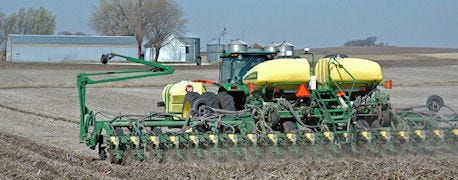May 8, 2013

Despite the late-season snow, spring is officially here and farmers are patiently waiting to hit the fields.
Some basic equipment maintenance done during an unusually long fall and winter may not be enough to avoid costly downtime during planting season.
Extra preparation now will result in more reliable equipment performance during planting season, says Andrew Hamilton, CHS director of marketing for lubricants.

Last-Minute Prep For Spring Planting
If the engine and hydraulic oil wasn¹t changed before machinery was put into storage, Hamilton recommends a fresh supply before planting starts. As oil sits, contaminants build up that could be harmful to seals, gaskets and the engine itself,² says Hamilton. The constant interaction of condensation from heating and cooling the engine can cause moisture to accumulate in the oil. An oil change now will prevent gummy blocks and plug-ups in oil filters.
In-Field Maintenance
Proper equipment maintenance is equally important in the field, says Hamilton. Additional grease is required throughout the planting season. One area many farmers overlook is grease compatibility ¬ making the wrong choice can cause serious damage.
The first thing to know about grease is whether the one they're using to maintain equipment is compatible with what they have used in the past, says Hamilton.
Many equipment owners are surprised to learn that it's actually the grease's thickener—not color—that determines its compatibility with another grease. He notes that many people are accustomed to a certain color of grease, but that not all greases of the same color are compatible with each other.
Grease is comprised of three parts: base oil, thickener and additives, explains Hamilton. The base oil is similar to the base oils used in engine and hydraulic oil. The thickener is what causes the grease to become paste-like. And the additives take care of lubrication and anti-oxidation.
When two grease products are chemically incompatible, both can break down and create metallic salts. The grease mixture becomes gritty or separates, says Hamilton. Instead of lubricating, a bad grease combination can actually wear down the metal exposed to it.
Hamilton recommends referring to manufacturers' grease guides to compare the different thickeners, such as calcium complex, lithium or polyurea, to determine their compatibility with one another before stocking up on grease for the season.
Viscosity Shift
Most farmers use a lower-viscosity grease during the winter due to the colder temperatures. With warmer weather, it's important to properly replace grease on axles, pivots, bearings, U-joints and pins with a compatible higher-viscosity grease, Hamilton adds. And be prepared to apply more grease throughout the planting season. It's a good idea to keep an extra supply on hand this spring.
For more advice on lubricants, fuels and other energy inputs throughout the year, check out the Cenexperts blog written by Hamilton and other energy experts with CHS at www.TanksofThanks.com
Source: CHS
Every decision that you make influences the size and scope for corn yields. From the corn hybrid you select to the seeding rate and row width you choose. Download our FREE report over Maximizing Your Corn Yield.
You May Also Like




